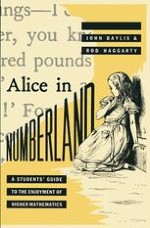1988 | OriginalPaper | Chapter
Unique Factorisation — in which trivial arithmetic reveals a glimpse of hidden depths
Authors : John Baylis, Rod Haggarty
Published in: Alice in Numberland
Publisher: Macmillan Education UK
Included in: Professional Book Archive
Activate our intelligent search to find suitable subject content or patents.
Select sections of text to find matching patents with Artificial Intelligence. powered by
Select sections of text to find additional relevant content using AI-assisted search. powered by
This chapter concerns mainly familiar old friends, the set ℕ of positive whole numbers variously known as the natural numbers or counting numbers, { 1, 2, 3, 4, …}. We think of counting as a very primitive notion firmly rooted in reality, yet already the innocent three dots in { 1, 2, 3, 4, …} may have taken us beyond reality into the realms of pure thought. The dots are usually interpreted as ‘and so on for ever’, which expresses our notion that ℕ is an infinite set. Cosmologists have still not made up their minds whether we live in a finite or an infinite universe, and in the former case there could be no such thing as an infinite set of real objects. However, mathematicians do not, in general, see this as a problem, and confidently assume that infinite sets (even if they are only sets of mental objects) can be handled with safety.
